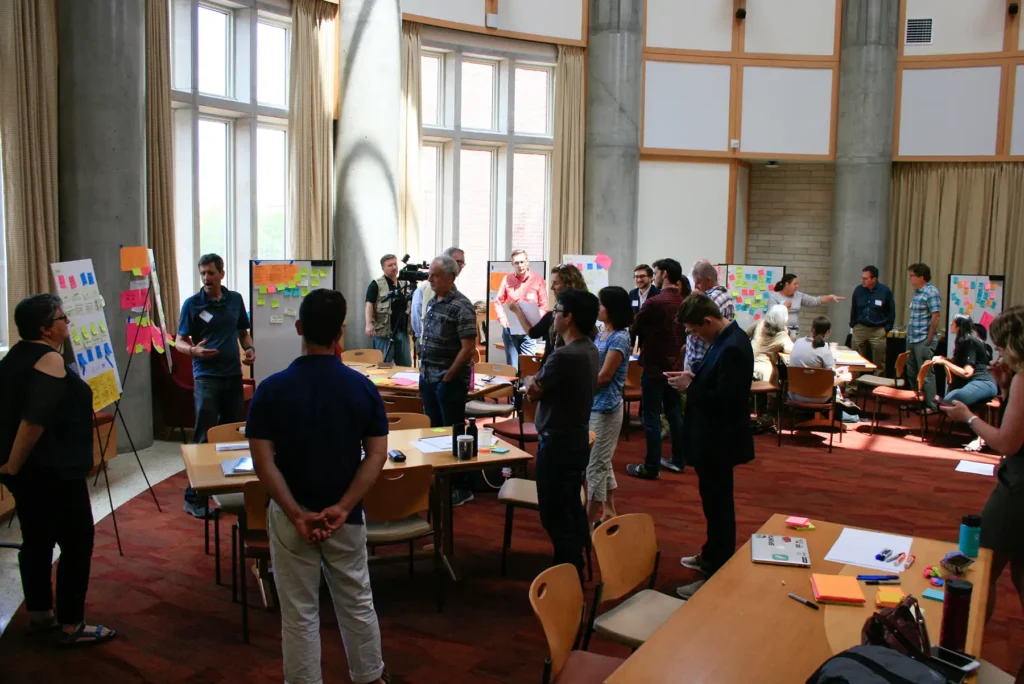By Alan Gottlieb
Introduction
One cold December evening, a year after a police officer killed a mentally-ill man in the northwest Colorado town of Rangely, the dead man’s wife sat next to the officer and forgave him — wishing him peace of mind and absolving him of the guilt that had plagued him since the shooting.
To many of the 35 town residents and officials seated around a rectangular array of tables and against the walls in the windowless conference room, it was a cathartic moment. Around the room, people wiped away tears. It was almost as if the room itself exhaled. The shooting had happened a year earlier, and had been the subject of much gossip but precious little official information.
This extraordinary community meeting came about because Niki Turner, editor and owner of the local newspaper, the Rio Blanco Herald Times, had been stymied by town officials when she tried to learn about the shooting and official investigations into it. So she reached out to Susan Greene, editor of the Colorado Independent, a Denver-based nonprofit news organization. Turner had never come across a story of this magnitude, and was seeking help reporting the complex and nuanced issues surrounding the shooting and its aftermath that town officials were trying to keep hushed.

After four months of prying loose records, digging, and interviewing, in November 2019 the two news outlets published Through the Cracks: A stranger, a police shooting, and a small town’s silence, a two-part series on the shooting. Publication of the story came 11 months after Rangely Police Lt. Roy Kinney shot Daniel Pierce dead as he sat behind the wheel of a stolen pickup truck on a dark country road.
In the first minutes of that December community meeting, Daniel Pierce’s widow, Debra Pierce, turned to Kinney and spoke through tears. “Our daughter Ashley and I both wanted to write letters to you and all the officers involved,” she said. Kinney, a rangy, bald-pated man, reached out and put his arm over Pierce’s shoulders. His eyes watered.
“We wish we could help you not be traumatized by what happened,” she continued. “That’s very important to us because I know you were doing a job…She didn’t blame you. I don’t blame you.” Now Pierce was crying as well.
“I am sorry you had nobody to talk to. I wish I could have reached out to you and talked to you.”

Kinney lost his job in the shooting’s wake. Under threat of a civil suit from the town, he had to sign a retirement agreement that forbade him from “disparaging” the town. The enforced silence, he said in the meeting, was excruciating. He said he suffered from Post Traumatic Stress Disorder after the shooting.
“Being suppressed makes you depressed,” Kinney said in a slow, soft drawl. “I thought I knew what depression was, but I had no clue until this. To talk to Debra and get some insight into her life has been very helpful.”
One of the project’s main findings was that Rio Blanco County suffers from a woeful lack of mental health resources available to its residents, and that public safety officials have received little or no training on dealing with people suffering a mental health crisis. Better training might, just possibly, have prevented Daniel Pierce’s death.
The deeply reported stories did what the best journalism does: Revealed the ambiguities and gray areas that comprise almost all complex human interactions. The stories contained no villains and no heroes: just a collection of people trying to cope with a challenging and fraught situation. They did their best, and they made mistakes that had fatal consequences.
The town’s manager, mayor and police chief weren’t happy that Turner and Greene were working on a story. They said there was little to be gained by dredging up a year-old incident. But as that December community gathering demonstrated, sunlight is, in fact, an excellent disinfectant. The stories’ publication began a healing process for the town and the people involved that reached its zenith at that public session.
How the partnership between Turner and Greene came about, and how they worked together — using Turner’s local contacts and Greene’s investigative reporting expertise to ferret out the story — provides an excellent example of how newsrooms working together can produce stories that neither would have been able to produce by going it alone.
It also offers a few lessons about how reporting collaborations can help produce stories that outlets might struggle to do on their own, and how news organizations can advance their stories and play a vital role in community convening around important issues in the communities they cover. Those lessons are discussed at the end of this study.
Forming a partnership
Greene and Turner serve together on the board of the Colorado Press Association. In July 2019, Turner was in Denver for the CPA annual conference. At an informal gathering in Greene’s backyard, the two women started chatting.

“Susan asked me what kind of stories I worked on, because obviously it’s very different than what she does,” Turner recalled in a recent interview with the Colorado Media Project. Turner mentioned a story that had eluded her, and that she still wanted to pursue: A mentally ill man named Daniel Pierce, a newcomer to Rangely, had been shot dead by Police Lt. Roy Kinney back in December 2018, and the town and the county had locked down any information about the case.
Turner knew that Kinney and then-police chief Vincent Wilczek had been put on paid administrative leave after the shooting, but after that, all sources of official information went silent. “It kept bothering me that these two long-term officers just vanished. Had they resigned? Retired? Been fired? I knew there was an internal affairs investigation, but that’s all I knew. I asked about these things, but I couldn’t get an answer.”
Turner’s story of the stonewalling set Greene’s investigative reporter antennae to vibrating. “I thought I could help Niki with a few public records requests,” she said. “She didn’t know how to go about that kind of work, and it’s my area of expertise.”
For Greene and the Colorado Independent, the timing was ideal. Greene, along with Indy Managing Editor Tina Griego, have been pondering a strategic shift in focus for the popular non-profit news site. What if, instead of running their own organization, they became a roving band of reporters – what Greene calls a “collaborative reporting strike team” — working with other Colorado newsrooms to bring unwritten stories to light?
Greene specializes in investigations. Griego prefers deeply reported human interest stories. They figured they could provide on-the-job training to rural and ethnic-media newsrooms, working with reporters on stories the reporters knew about but lacked capacity to produce on their own. When attending Colorado Press Association board meetings and conferences, Greene frequently gets asked by editors from smaller outlets if a reporter can call her for advice on a story. This new model would be a logical extension of that. She and Griego would provide hands-on training by working with reporters, and then be available for future check-ins as well.
The timing was opportune for the reporters to consider such a shift. In mid-2020, the Indy and nine other media organizations plan to move into a collaborative newsroom in the new Rocky Mountain Public Media headquarters in downtown Denver. The Journalism COLab, as it will be called, will provide an opportunity to work more closely with the Colorado Press Association and its members, both inside and beyond the COLab’s walls. Greene and Griego also were embarking on a strategic planning process with the Colorado Media Project to refresh their business model — with a goal of adding this type of capacity-building and community engagement to their work.
Greene has been running the Indy since 2013, after 13 years as a reporter and metro columnist at The Denver Post. She also did newspaper reporting stints in Las Vegas and Victorville, Calif. While she had opportunities to do reporting, her first love, she also had to do what all nonprofit news entrepreneurs must: spend a lot of time raising money. Finding a way to get back to reporting, at least closer to full time, would be a dream.
Rangely seemed like a perfect test case. “Niki is so smart, and I sensed she would be intensely into this story,” Greene said. “It was an ideal story to start out with.”
A quiet partnership
Greene had no idea how all-consuming the story would become. But she quickly figured out there was a lot to uncover, and that filing a few Colorado Open Records Act requests would not be enough to crack the case.
She started probing to see what she could find. At that point, neither woman told anyone in Rangely that they were working together. Town officials thought it was “just one pushy big-city reporter nosing around,” Greene said. The idea was that she would figure out if there was a story, and what that story was before Turner had to “come out of the closet” and reveal that she was involved in the project as well.
Turner freely acknowledged that the idea of ruffling feathers in so small a town made her nervous. She and her husband live 55 miles east in Meeker — where he serves on the town council — and some long-standing friction exists between Rio Blanco County’s only two towns of any size.
So it made sense for Greene to do the initial reporting work and for Turner to stay in the background until they ascertained whether there was a story worth pursuing. That way, if there was no story, Turner wouldn’t have needlessly strained her relationships in Rangely.
As it turned out, there was a story — a big one — so in the early fall, Turner and Greene started working it together, openly.
The pressures of small-town journalism
When Turner was growing up in Glenwood Springs, her parents owned the distribution business for the Denver Post, Rocky Mountain News, New York Times, USA Today, and Wall Street Journal throughout the region from Glenwood to Aspen to Vail. As a young child, “I slept on newspaper bundles in the back of the car seven days a week,” she said. Almost literally, newspaper ink runs in her blood.
Turner, with her daughter Caitlin and husband Pat, bought the Herald Times in the fall of 2016. Niki Turner had worked for the paper since 2001, initially “counting quarters from the newspaper racks and stuffing envelopes” while she homeschooled her four children. Eventually, “people figured out I could spell and edit, so I started doing that.”
She also did sales, front office billing, design, layout, and writing. In other words, a typical small-town weekly newspaper job as a jack-of-all-trades. Now that the family owns the paper, Turner’s adult daughter helps with layout, design, and a bit of reporting. Pat distributes the 1,500 copies printed each week. “The paper is still alive, which is our number one goal,” Turner said. “We don’t want it to die on our watch.”
Turner is quick to say she has no formal journalism training, She took one newspaper class as a senior at Glenwood High School, and landed in hot water as a result. Someone tipped her that the Roaring Fork School District had spent $8,000 on sports equipment, either wrestling mats or something for the football team — she can no longer recall. As a serious student and a non-athlete, this incensed her.
“I was in an American government class that was a graduation and pre-college requirement and we were sharing textbooks, meaning I couldn’t even take one home every night,” she said, a tinge of outrage still evident in her voice. So she wrote a column criticizing the district for skewed priorities.
The high school paper was inserted into the daily Glenwood Post in those days, so influential city residents saw her column. “Apparently, the superintendent got a hell of a lot of phone calls, and I ended up being hauled into his office,” she said.
The superintendent was furious. Flying in the face of the First Amendment, he told Turner that if she ever wrote anything like that column again, she would be expelled. “That was my introduction to journalism: ‘Oh dear, I could get in trouble for this,’” she said with a laugh.
Once Turner and Greene decided there was a story to tell in Rangely, Greene tried a couple of times to have phone conversations with Town Manager Lisa Piering. “She wasn’t satisfied at all with the responses she got, so she suggested I go down there and try in person,” Turner said. “We kind of played good-cop bad-cop roles.”
Turner made an appointment to meet with Piering. She explained that she wasn’t “the big scary Denver journalist,” but a local reporter who lived in Rio Blanco County. It didn’t help.
When Turner got to Rangely for the meeting, Mayor Andy Shaffer was there as well. From the outset, Turner said, the meeting was tense and confrontational. The two officials told her that she would destroy the town if she dredged up the details of this unfortunate incident.
“I felt like I was back in the superintendent’s office, except at 18 I probably was more rebellious and had more of a spine,” Turner said. “If I had to list the top five difficult things I’ve ever had to do, this was in the top five.”
Shoe-leather reporting
Meanwhile, Greene had tracked down Daniel Pierce’s mother in California and his widow, Debra, in Missouri. At Greene’s prompting, Turner requested and received Pierce’s autopsy report (“I had no idea you could request that and get it. I could hear Susan rolling her eyes.”) The reporting was picking up momentum.
The next big break came when Lt. Roy Kinney decided to talk to Greene and Turner. Getting to know Kinney, Greene said, was second only to working with Turner on her list of the most rewarding aspects of this project.
“He defied all my expectations and I think it’s safe to say I defied his,” Greene said. “We got to really know each other and that was a joy. He was incredibly affected by this incident, and I was surprised by how much he needed to talk.”
Greene sees great value in the joint reporting she and Turner did. Not only did they learn about each other, but “you see new ways into the story.” For an outlet like the Independent, especially in its new role as a “collaborative reporting strike team” for the state, “you can’t just parachute into a town. You need a partner to explain the dynamics.”
Different sources also responded to the two women in different ways. As a county-wide newspaper, the Herald Times — and Turner in particular — had a good working relationship with Sheriff Anthony Mazzola. Because of animosity between Kinney and Mazzola, Kinney was wary of Turner. But he was desperate to talk and readily opened up to Greene.
And why did Kinney talk, in the face of threats from the town? In an interview with CMP, he said that his retirement agreement stipulated that he couldn’t say anything to disparage the town. He said a tangle of animosities among various players left him fearful that some powerful people in Rangely were out to get him.
But in the end, the need to talk overwhelmed the “tremendous fear” he felt about speaking out. He had injured his neck during the incident that led to the shooting, and has been diagnosed with PTSD, “so I was just sitting around my house and very few people ever came by to check in on me.”

He also said that the redacted internal affairs investigation that was released presented a warped view of the chain of incidents that led him to shoot Pierce. He said he was worried that he would be portrayed in the stories an unfair and inaccurate light. Greene and Turner eventually acquired the full internal affairs report from a source. But Kinney heard rumors that the story was going to be focused on “how I got away with murder,” so he called Greene and agreed to talk.
When the time came to publish the story, Turner was nervous. “The fear and trepidation, other than the threats from the town, is that you’re going to piss off your advertisers, people are going to hate the paper and cancel their subscriptions,” she said.
Much to her surprise, none of that happened. In fact, in the month after publication, the paper had added eight online subscriptions and a couple more in print. “That’s a big deal for us in a month,” Turner said.
Among town and county officials, only Rangely Mayor Andy Shaffer still seemed outwardly resentful of the coverage a month after publication. “What I see as tough for a small community is rekindling something that happened a while back,” Shaffer said during the December 2019 community meeting. “As mayor, I didn’t sign up to do what happened with this whole deal.”
Even Shaffer, however, acknowledged publicly that “the article was good, the way you covered it was good. I don’t agree with some things, but that’s life, right?”
A gathering to heal
After the articles published simultaneously on the Colorado Independent website and in the print and online editions of the Rio Blanco Herald Times, Greene and Turner received a flood of attention from across Colorado — the vast majority of it positive — for the deep and nuanced reporting and writing. But they felt their work wasn’t quite done. There was no sense of true closure. That’s why Greene decided it would be a good idea to hold a public forum in Rangely.
“Mainly we suspected that the topics the story addressed (particularly the lack of mental health services and training available to local residents and law enforcement officers) would fizzle without an in-person follow up to the story,” Greene said. “And there had never been anyone speaking up for or representing Daniel Pierce after his death, and we felt bringing in his family would make the stakes seem more real and less hypothetical to town officials who wanted to brush his killing under the rug.”

Greene convinced Debra Pierce, Daniel Pierce’s widow, to fly out to participate. She invited Pierce’s mother, Rose Nuttbrock, to come from California as well, but Nuttbrock wasn’t emotionally up to it.
To Kinney, Debra Pierce’s presence was a healing godsend. Greene introduced them and they spent a couple of hours together before the public meeting. “I had been praying that Debra or Rose (Pierce’s mother) or both of them would show up,” Kinney said. “I needed to open that door to them and talk. My reaction, beyond the emotional, was that it was a good thing for both of us.”
The public meeting lasted more than two hours. In addition to Pierce, Kinney, Greene, and Turner, Sheriff Mazzola attended, as did police chief Ty Hamblin, Mayor Andy Shaffer, the CEO of the regional mental health service provider, and about 30 other townspeople.
Near the end of the meeting, a woman who said she had recently moved to Rangely praised those in attendance for their openness and honesty. “I have lived all over the country, and been to a lot of community meetings,” she said. “For such a small community to come together with so much representation, it is absolutely incredible. You all should be incredibly proud to be in this room together.”
Lessons learned
What lessons can journalists and other extract from the experiences of Greene, Turner, and the town of Rangely? While each collaborative project is unique, there are lessons from this one that seem broadly applicable. And in the case of the Rangely project there’s a lesson for public officials as well as journalists.
- The value of collaboration is greater than the sum of its parts. Bringing journalists from multiple newsrooms together almost always nets an exponential benefit. Reporters learn from each other, feed off each other, and complement one another’s strengths. Combining the local knowledge of a small-town reporter with the investigative savvy of a metro reporter proved to be an especially powerful combination. Respect for one another’s strengths builds trust and capacity among reporters.
- Relationships don’t end once a story is published. As trust in journalism erodes nationally, building relationships between journalists and the communities they serve becomes increasingly important. Publishing a story with the impact of Between the Cracks on a small town and then dropping it borders on the irresponsible. As the positive outcomes from the Rangely community meeting demonstrate, follow-up and follow-through show caring and commitment. That, in turn, builds trust and confidence in reporting and reporters.
- Openness and transparency yields benefits; stonewalling backfires. Rangely town officials hoped the story would go away and that they could make that happen by stiff-arming the local editor. In the end, dogged reporting surfaced the story, and gossip and innuendo was replaced by factual information. Public officials could have saved everyone headaches and heartache by releasing public information to journalists in a timely and humane fashion.



